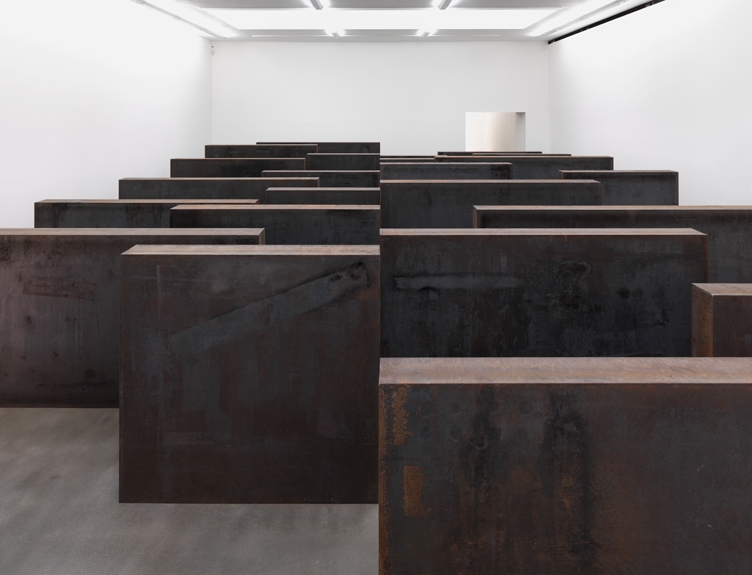From 2015: Serra’s slouching slabs on show in a two-part show at Gagosian, London have an existential quality
When David Hammons took a leak on a Richard Serra sculpture on a New York street in 1981 and, as legend has it, got arrested, titling the whole event Pissed Off, he took it for the team: what more eminently defaceable public sculpture than that of Serra? Yet if Serra’s slouching slabs seem inert in a municipal plaza, when inside a gallery, as in Gagosian’s two-part show in London, an inversion of public and private space occurs that is uniquely the artist’s. Take Ramble (2014), a mazy layout of 24 23cm-thick slabs of rolled steel, of varying heights, arranged in uneven rows. Shunted Frogger-style through angled alleys, which alternately rise and dip like a pixelated sea, the viewer’s means of intellectual negotiation is restaged as anxious public movement: the jerking dash of crossing a street between humming trucks. Serra’s work obliges – often bullishly – a viewer / work relationship that is both heightened and sharpened by the blank mass of industrial matter, like Cary Grant and the crop duster.
In Backdoor Pipeline (2010), two tall walls of curved steel meet and form an ogee arch. The 15m-long walkway within is part-cave, part-oesophagus; turn right out of the other end and it’s a rusted doughnut; turn left and it’s a robot’s ribcage. In Serra’s extrapolations of the essential premises of 1960s Minimalism, such allusive whimsy is beside the point; ‘It is what it is, and it ain’t nothin’ else’, as Dan Flavin had it. Yet it’s hard to miss in Serra’s autumnal period – meant, irresistibly, both in terms of his work’s weathered orangey-browns, and his own advancing years (he’s seventy-five) – a pictorial quality that belies the conceptual roots of his practice and gives it a communicative urgency. Dead Load (2014), for instance, takes the form of two steel slabs, one lying on the other, each around 80cm thick. Because the upper slab has been left to weather outside, it’s taken on the mottled patina of a Richter abstract, and its slightly wider footprint gives the thing the tension of an object flipped on its back, the first steps of an inverted ziggurat. Its visual associations – sarcophagus, sacrificial altar, the Looney Tunes anvil – are deathly. It is what it is: an image of a smaller thing pressurised by a larger, forced downward.
Serra’s phenomenological thrills are hard to sustain and even harder to repeat. Where his work succeeds best – where it avoids the merely spectacular – is in its insistence on the graphic integrity of sculptural form. In Gagosian’s second space, a huge black paintstick drawing, Double Rift #2 (2011), is charged with the residue of bodily pressure, striated with thick marks more gouged than applied. Serra’s work has always elided the making hand with the thinking mind, most effectively here in London Cross (2014), an installation of two steel walls, each 214cm high, which bisect one room from corner to corner, one resting on the other at their midpoint. In the gallery’s floorplan, it’s an X, like a drawing, suggesting at once the inaccessible – two parts of the room remain hidden – and a kind of existential cartography: you are here.
This article was first published in the January & February 2015 issue.
